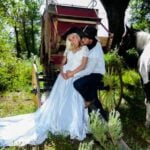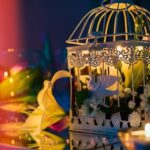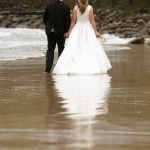Are you wondering what to wear to a formal wedding? Understanding the dress code for a formal wedding is essential to ensure that you dress appropriately for the occasion. Traditionally, formal weddings have specific expectations when it comes to attire, and it’s important to adhere to these guidelines while also expressing your personal style.
When attending a formal wedding, it is crucial to understand the significance of dressing appropriately. Your attire reflects respect for the couple getting married as well as the importance of the occasion. In this article, we will explore the traditional expectations for formal wedding attire and provide guidance on how to navigate the dress code with confidence.
Deciphering between black tie and white tie dress codes can be challenging. The difference in these dress codes significantly impacts what you should wear to a formal wedding. In the following section, we will delve into details about black tie and white tie dress codes, providing examples of appropriate attire for each and offering tips on how to coordinate with the wedding theme.
Decoding the Dress Code
When it comes to attending a formal wedding, understanding the dress code is crucial in ensuring that you are appropriately dressed for the special occasion. Two common dress codes for formal weddings are black tie and white tie. Deciphering the differences between these two dress codes can help you select the perfect attire for the event.
Black Tie Attire
Black tie attire typically calls for a sophisticated and polished look. For men, this often means donning a classic tuxedo with a black bowtie and cummerbund. Pairing the tuxedo with a crisp white dress shirt and patent leather shoes completes the ensemble. Women have more flexibility in their attire options, with elegant floor-length gowns or chic cocktail dresses being popular choices for black tie events.
White Tie Attire
On the other hand, white tie attire is even more formal than black tie, requiring a higher level of sartorial elegance. Men are expected to wear a tailcoat, which features long tails at the back, along with a winged collar shirt, white vest, and white bowtie. For women, white tie occasions call for full-length evening gowns in rich and luxurious fabrics, often accompanied by statement jewelry and elaborate hairstyles.
Understanding the distinction between black tie and white tie dress codes allows you to select an outfit that aligns with the formality of the event while also reflecting your personal style. Whether you opt for the timeless sophistication of a tuxedo or the glamour of an evening gown, dressing in accordance with the specific dress code ensures that you will look effortlessly stylish at any formal wedding.
Formal Wedding Attire for Men
When it comes to dressing for a formal wedding, men should adhere to the dress code while also considering their own personal style. For a black tie wedding, men typically wear a tuxedo with a black bow tie and cummerbund, while white tie weddings require a tailcoat, formal trousers, and a white bow tie. It is essential for men to understand the subtle but crucial differences between these two dress codes in order to make the right attire choice.
For those attending a black tie wedding, a classic black tuxedo with a crisp white shirt is the way to go. A well-fitted suit with peak lapels or shawl collar can elevate your look effortlessly. In terms of accessories, opt for black patent leather oxford shoes and a sleek watch to complete the ensemble.
Meanwhile, at a white tie wedding, gentlemen are expected to wear tailcoats paired with pleated formal trousers and white gloves. A white piqué waistcoat and bow tie are essential components of this ultra-formal attire.
When deciding what to wear to a formal wedding as a man, it’s important to consider not only the dress code but also the venue and theme of the event. For indoor weddings in grand ballrooms or elegant venues, traditional formal attire is suitable. However, for outdoor or destination weddings, lighter fabrics such as linen or lightweight wool may be more appropriate while still adhering to the formal dress code.
In order to feel confident and stylish in their formal wedding attire, men should also pay attention to small details such as grooming and etiquette. Keeping facial hair neatly groomed and ensuring that shoes are polished can make all the difference in creating an impeccable look for such an important occasion.
Ultimately, choosing what to wear to a formal wedding requires attention to detail and respect for tradition while allowing room for personal expression within the constraints of each unique dress code.
Formal Wedding Attire for Women
When it comes to attending a formal wedding, women have a wide range of attire options to choose from. Whether the dress code calls for black tie or white tie, it is essential to select an outfit that reflects sophistication and elegance. Understanding the expectations for formal wedding attire can help women navigate their choices with confidence and style.
Options for Formal Dresses and Gowns
For a black tie wedding, women have the option of wearing floor-length gowns or elegant cocktail dresses. When choosing a gown, consider luxurious fabrics such as silk, satin, or chiffon, and opt for classic silhouettes with subtle embellishments. For white tie affairs, full-length evening gowns are the standard choice. These gowns often feature intricate details such as lace, beading, and embroidery, and should be paired with formal accessories such as opera gloves and statement jewelry.
Flattering Silhouettes and Colors
When selecting a formal dress for a wedding, it’s important to consider which silhouettes and colors are most flattering for your body type. A-line dresses are universally flattering and can complement various body shapes, while empire waist gowns are ideal for creating an elongated silhouette. Additionally, jewel-toned colors such as emerald green, sapphire blue, and deep burgundy are popular choices for formal weddings as they exude elegance and richness.
Accessorizing for Formal Weddings
Accessories play a crucial role in elevating the look of a formal wedding ensemble. When accessorizing for a formal event, opt for statement jewelry pieces such as chandelier earrings or a dazzling necklace to add glamour to your outfit. Consider carrying an embellished clutch or small evening bag to complete your look. Shoes should be elegant yet comfortable – classic pumps or strappy heels in neutral tones like black or nude are excellent choices for formal wedding attire.
Overall, when selecting what to wear to a formal wedding as a woman it is important to keep in mind the dress code specified on the invitation as well as personal style preferences. By carefully choosing the right dress style that flatters the figure; selecting complementary accessories; and paying attention to etiquette guidelines one can confidently embrace their perfect look.
Considerations for the Wedding Venue
When it comes to attending a formal wedding, one of the most important considerations for what to wear is the wedding venue. The location of the wedding can greatly impact the attire choices, and it’s essential to dress appropriately while also feeling comfortable and confident. Whether the wedding is taking place indoors, outdoors, or at a destination, understanding the venue’s impact on attire is crucial.
For indoor formal weddings, such as those held in grand ballrooms or elegant venues, guests are typically expected to dress in sophisticated and polished attire. This may include classic formal gowns for women and sleek suits or tuxedos for men. Pay attention to any specific guidelines provided by the couple when choosing your outfit for an indoor formal wedding, and consider opting for rich fabrics and elegant accessories to complement the luxurious setting.
On the other hand, outdoor formal weddings present a different set of considerations for attire. While still maintaining a sense of formality, guests may need to take into account practical elements such as weather conditions. For example, if the wedding is taking place in a garden or vineyard setting, women might opt for lightweight formal dresses in breathable fabrics while men could choose lighter-colored suits instead of traditional black tuxedos.
Lastly, destination formal weddings offer a unique opportunity to incorporate elements of the location into your attire while still respecting the dress code. If attending a formal beach wedding or a celebration in an exotic locale, look for elegant yet relaxed options that align with the destination’s vibe. Consider flowy maxi dresses for women and linen suits for men to strike the perfect balance between formality and comfort.
By considering these venue-specific factors when choosing what to wear to a formal wedding, guests can confidently select attire that not only adheres to the dress code but also reflects their personal style and ensures they feel at ease throughout the celebration.
Etiquette and Cultural Considerations
When attending a formal wedding, it is essential to consider etiquette and cultural considerations to ensure that you dress appropriately for the occasion. Different cultures and regions have varying expectations when it comes to formal wedding attire, and it is important to be mindful of these differences. Here are some tips for navigating etiquette and cultural considerations when selecting your outfit for a formal wedding:
- Research the Cultural Norms: If you are attending a wedding that is rooted in a specific culture or tradition, take the time to understand the typical attire worn for such occasions. For example, traditional Indian weddings often call for vibrant colors and intricate embellishments, while Japanese weddings may require more subdued and elegant ensembles.
- Respect Religious Customs: In some cases, formal weddings may be held within religious settings, such as a church or temple. It is important to dress with respect for the religious customs associated with the venue. This may include covering shoulders or wearing attire that is considered modest by the religious community.
- Consider Regional Influences: Whether you are attending a formal wedding in New York City or in a rural town, the regional influences on fashion and style can impact your attire choices. Take into account any regional trends or preferences when selecting your formal wedding outfit.
Understanding and respecting etiquette and cultural considerations can help you make informed decisions about what to wear to a formal wedding, allowing you to participate in the celebration with confidence and respect. By embracing cultural diversity and traditions, you can contribute to the meaningful experience of the special day while presenting yourself in an appropriate manner.
Remember that while it is important to honor cultural customs and etiquettes when dressing for a formal wedding, it is also an opportunity to express your personal style tastefully within these parameters. This balance ensures that you not only adhere to etiquette guidelines but also feel comfortable and confident in your chosen attire.
Styling Tips and Trends
When attending a formal wedding, it is essential to keep up with the latest trends in formal attire to ensure you look stylish and sophisticated. Whether you are a bride, groom, part of the bridal party, or a guest, staying updated on current trends can help you make informed decisions about what to wear. One of the recent trends for men’s formal wedding attire is a move towards more modern and sleek looks.
This includes opting for slim-fit tuxedos or suits in deep, rich colors such as navy blue or charcoal gray. Additionally, patterned dress shirts and statement bowties are gaining popularity as stylish accents to elevate the overall look.
For women attending a formal wedding, timeless elegance is always in style. Classic silhouettes such as A-line gowns or sheath dresses are popular choices that exude sophistication. In terms of colors, jewel tones like emerald green and royal blue are making a statement in formal wedding fashion. Adding embellishments such as beading or lace can also bring an extra touch of glamour to your ensemble.
When considering accessories for both men and women, minimalism is key. For men, sleek cufflinks and classic leather shoes can enhance the overall look without overshadowing the outfit. Women can opt for understated jewelry like small stud earrings or delicate necklaces to complement their attire without overpowering it.
Styling tips for achieving an elegant look at a formal wedding include paying attention to the fit of your clothing. Tailoring your outfit to ensure it fits well and flatters your figure is essential for creating a polished appearance. Considering the formality level of the event is also crucial – if it’s an evening affair, darker colors and more formal attire would be appropriate compared to a daytime wedding event.
Men’s Trend Slim-fit tuxedos/suits in deep rich colors.
Men’s Trend Patterned Dress Shirts & Statement Bowties
Women’s Trend Timeless Elegance & Classic Silhouettes
Women’s Trend Jewel tones & embellishments for gowns/dresses.
Dressing for Special Roles
When it comes to dressing for a formal wedding, both the bridal party and guests have important roles to play in maintaining the dress code and overall atmosphere of the event. For brides and grooms, it’s essential to convey their desired level of formality through their attire, setting the tone for the entire celebration.
Meanwhile, members of the bridal party should coordinate their outfits to complement the couple’s chosen style, ensuring a cohesive and polished look. Additionally, guests must adhere to the dress code while also expressing their personal style within the established guidelines.
Brides and grooms are typically expected to adhere to the formal dress code with precision. For traditional black-tie weddings, grooms often wear tuxedos with formal accessories such as bow ties, cummerbunds, and patent leather shoes.
White-tie weddings require an even higher level of formality, with grooms donning a tailcoat ensemble complete with white bow tie and vest. Brides should select wedding gowns that reflect the level of formality specified by the dress code, whether it’s an elegant ball gown for a white-tie affair or a sophisticated fitted silhouette for a black-tie event.
As part of the bridal party, members such as bridesmaids and groomsmen play a crucial role in upholding the formality of the occasion. Bridesmaids’ dresses should complement but not overshadow the bride’s gown, often following similar color palettes or styles while adhering to any specified dress codes. Groomsmen typically match their attire to that of the groom’s party, ensuring uniformity in formalwear choices such as suits or tuxedos according to the dress code.
For wedding guests attending a formal celebration, it’s essential to respect both the couple’s wishes and the formality of the event when selecting attire. While expressing individual style is encouraged, guests must adhere to any specified dress codes such as black-tie or white-tie by choosing appropriate evening wear or formal attire. This might include floor-length gowns for women and tuxedos or dark suits for men depending on the designated level of formality.
Conclusion
In conclusion, understanding the dress code for a formal wedding is essential for ensuring that you dress appropriately for the special occasion. Whether it’s a black tie or white tie event, knowing the traditional expectations and guidelines can help you make informed decisions about what to wear. By decoding the dress code and considering factors such as the wedding venue and cultural considerations, you can navigate formal wedding attire with confidence.
When it comes to formal wedding attire for men, options range from classic suits to elegant tuxedos, with accessories playing a key role in completing the ensemble. For women, formal dresses and gowns in flattering silhouettes and colors are popular choices, along with statement accessories to complement the look. It’s important to remember that the wedding venue can impact attire choices, whether it’s an indoor, outdoor, or destination wedding.
As trends in formal wedding attire continue to evolve, it’s also helpful to consider styling tips and current fashion trends when preparing for a formal wedding. Whether you’re a member of the bridal party or attending as a guest, respecting the dress code while expressing your personal style is key.
Embracing this opportunity to dress your best not only shows respect for the couple getting married but also allows you to feel confident and sophisticated on this special day.
In summary, navigating formal wedding attire requires thoughtful consideration of traditional expectations, venue considerations, cultural etiquette, and personal style preferences. By embracing these guidelines and incorporating your own sense of style into your outfit choice, you can attend a formal wedding with confidence and grace.所.
Frequently Asked Questions
What Do You Wear to a Formal Wedding as a Guest?
When attending a formal wedding as a guest, it’s important to choose attire that is elegant and appropriate for the occasion. For men, a dark suit with a tie is typically the best choice. Women have more options, such as a cocktail dress or a floor-length gown.
What Does It Mean to Dress Formal for a Wedding?
Dressing formally for a wedding generally means choosing attire that is sophisticated and refined. This could include a dark suit and tie for men, while women might opt for a chic cocktail dress or an elegant gown. It’s essential to adhere to the dress code specified on the invitation.
What Is Considered Formal Attire on a Wedding Invitation?
Formal attire on a wedding invitation usually indicates that guests are expected to wear their most elegant clothing. For men, this often means a tuxedo or a dark suit with a tie.
Women can opt for a floor-length gown or an upscale cocktail dress. It’s important to pay attention to any specific dress code requirements mentioned on the invitation to ensure appropriate attire for the event.

Welcome to my blog about home and family. This blog is a place where I will share my thoughts, ideas, and experiences related to these important topics. I am a stay-at-home mom with two young children. I hope you enjoy reading it! and may find some helpful tips and ideas that will make your home and family life even better!





